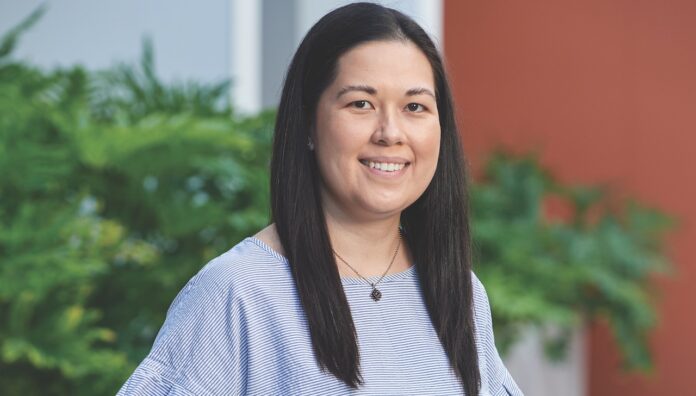Michelle Sweeney MPS loves hospital pharmacy, especially taking hospital care into the homes of youth with mental health issues.
What interested you in pharmacy initially?
I knew I wanted to complete a professional degree at university and loved chemistry in high school, so pharmacy seemed like a reasonable career choice. I’d never worked in a pharmacy before my pharmacy degree, but as soon as I started university and worked in a community pharmacy, I was confident I had made the right decision. I completed both my undergraduate and postgraduate studies at Curtin University in Perth, Western Australia.
How has your role changed in the past 10 years?
Hospital pharmacists are more deeply embedded into multidisciplinary teams within hospital environments, providing opportunities to be proactively involved in collaborative decision making earlier in the medicine management cycle. It’s been fantastic to witness increasing awareness among other health professionals of the unique set of skills and knowledge that pharmacists have and the contribution we make to quality use of medicines and improved patient outcomes.
Tell us about your new role in a Hospital in the Home (HiTH) team?
In a mental health youth HiTH team, I am providing clinical pharmacy services to patients aged 16–24 years, who can be safely and effectively managed in the home environment. During a typical 2-week admission, we visit patients daily at home, delivering care and interventions normally provided to inpatients in the hospital setting. The critical pharmacist role is finally being built into new service structures – from the start – as an essential member of the healthcare team. To see the impact of health care and how it supports these young people in their everyday lives is very rewarding. It’s wonderful to be deeply embedded in a multidisciplinary team where, as the pharmacist, I have the opportunity to lead medication management within the coordinated efforts of all members of the team.
What about your involvement with the PSA Annual Gold Questionnaire?
The questionnaire committee is a team of intelligent, inspiring, passionate pharmacists, and it is a privilege to work alongside those I admired when I was a pharmacy student and who have contributed so much to our profession over the years. I learn so much from the committee, particularly about exciting advancements in other areas of pharmacy practice beyond exposure in my own practice environment.
How does your PSA membership benefit you as a hospital pharmacist?
My membership gives me access to continuing education resources that broaden my knowledge of particular topics or areas beyond the hospital pharmacy context. The Essential CPE is a very useful resource, and inperson events are a great opportunity to network. A broad understanding of the pharmacy landscape allows me to be a better pharmacist within the hospital setting, particularly when I am involved in transitions of care between hospital and the community.
What’s your advice to ECPs?
Be open to any and every opportunity that is available, to further develop your skills and broaden your scope of practice. If you can’t find any, reach out to your contacts and don’t be afraid to network! There are plenty of experienced pharmacists out there who are eager to support enthusiastic and passionate early career pharmacists.
A day in the life of Michelle Sweeney MPS, Senior Clinical Pharmacist, Fiona Stanley Hospital, Perth, WA.
| 6.00am | Pre-work routine
An early-morning yoga class and a quick stop at my local coffee shop on the way to the office. |
| 8.30am | HiTH handover
Morning multidisciplinary handover meeting to discuss current patient list for the Youth HiTH service within the hospital. Doctors, nurses, occupational therapists, social workers and I, as the pharmacist, are allocated to home visits based on targeted interventions for each patient. |
| 9.00am | Clinical review
Discuss escalation of therapy prior to first home visit (with senior registrar) to Mr AB, newly diagnosed with bipolar disorder not adequately responding to monotherapy with olanzapine. Plan to initiate mood stabiliser therapy with lithium. Review recent blood tests and investigations to ensure baseline monitoring is completed prior to commencement. Review medical record for potential drug interactions, family and social history, and other factors that may influence medicine management. Print out information leaflets for Mr AB and family. |
| 10.00am | Home visit
Take hospital fleet car to Mr AB’s home for initial medical review by the senior registrar. Discussing rationale for proposed treatment plan, I provide information on lithium dosing, adverse effects, interactions and monitoring requirements. Mr AB is a football player who frequently takes ibuprofen for sports injuries. Discuss paracetamol use alongside topical treatments as an alternative, due to interaction with lithium. Mr AB consents to starting lithium tonight with supply arranged via his community pharmacy. Provide pathology form for a lithium level blood test in 5–7 days. |
| 12-3.30pm | Motivational interviewing time
Review notes for next home visit with Ms SZ, newly diagnosed with schizophrenia and having difficulties with adherence to oral risperidone. Unwilling yet for a depot formulation. Visit focuses on motivational interviewing to encourage adherence. Document interventions and outcomes for the day in medical records, which are discussed at the afternoon multidisciplinary meeting. |



 National Medicines Symposium 2024 speakers (L to R): Steve Waller, Professor Jennifer Martin, Professor Libby Roughead, Tegan Taylor[/caption]
National Medicines Symposium 2024 speakers (L to R): Steve Waller, Professor Jennifer Martin, Professor Libby Roughead, Tegan Taylor[/caption]


 This CPD activity is sponsored by Reckitt. All content is the true, accurate and independent opinion of the speakers and the views expressed are entirely their own.[/caption]
This CPD activity is sponsored by Reckitt. All content is the true, accurate and independent opinion of the speakers and the views expressed are entirely their own.[/caption]










